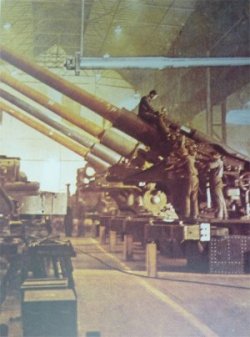
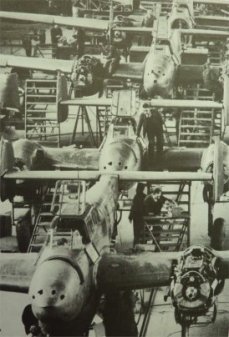
Wola defense, September 1939
On January 30th 1933, Adolf Hitler was chosen for chancellor of Germany. Soon after he became a dictator - Fuhrer of III Reich. From the very beginning of his reign Hitler, started the idea of German hegemony over Europe, which included expansion on east, which was named Drang nach Osten (pressure for east).
On 21st October 1933 Germany resigned from League of Nations, of which they were member since 1926. League of Nations was established few years after First World War on 10th January 1920. Organization consisted of 63 countries, it main object was to guarantee world peace.
After leaving the League, Germany started to increase military power, first in secret, then openly, disregarding Treaty of Versailles. In march 1935, so called military act was passed. As a result German army (Wehrmacht) increased its numbers over three times, and compulsory national service was introduced. In June of 1935 III Reich and Great Britain signed "sea act", which allowed Germany enlargement of Kriegsmarine (German navy). Armaments industry started building huge numbers of cannons, tanks and planes.
 |
 |
Production of German heavy cannons and fighters
On march 13 1938, annexation of Austria (Anschluss Osterreichs) became reality. Next day Hitler issued an act about Austria annexation into "Great Reich" as an Eastern March (Ostmark). This way goals of some political circles in both countries that were mentioned since end of WWI were achieved.
Afterwards Hitler turned his attention on Czechoslovakia. First he demanded Sudeten county, that was in possession of Czechoslovakia, but mostly inhabited by German minorities.
German demands were formulated on conference in Munich (29-30 September 1938). Participants of conference: Germany (A. Hitler), Italy (B. Mussolini), France (E. Daladier) and Great Britain (A. N. Chamberlain). On 30th of September agreement was signed without Czechoslovakia participation in the matter. As a result they had to give Sudeten county to Germans.
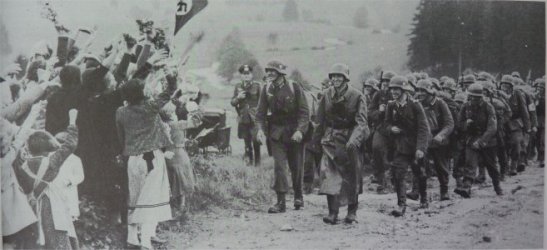 |
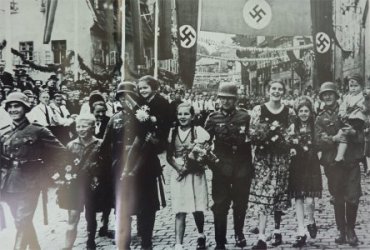 |
German minority in Sudeten county welcomes Wehrmacht soldiers
However this was not an end of Czechoslovakia partition. Czechoslovakia was made by Poland to give back Zaolzie county, over which dispute lasted since 1919. After polish ultimatum Zaolzie was taken over by polish army in October 1938 (2nd to 11th October). On 2nd November 1938 Hungary took southern Slovakia and Podkarpatska Rus (hun. Karpatalja). 16 March 1939 was an end of Czechoslovakia, Germany took over the rest of its territory and renamed area to Protektorat Böhmen und Mähren (Protectorate of Bohemia and Moravia). On slovakian territory pro-Reich First Slovakian Republic was established.
>/p>
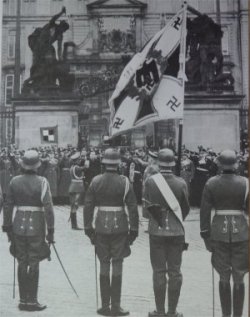
Germans on Hradcany in Praha (Prague)
Thanks to taking over the Sudeten Germans gained well fortified area, and what is more important Skoda factory, which had production potential equal with whole English armaments industry.
Poland was next. Polish government did not agreed on German demands over Gdansk (ger. Danzig) and so called Polish Corridor (ger. Polnischer Korridor). As a result Germans started negotiations with Poland's eastern neighbor (USSR), which object was joint diplomatic and military policy against Poland. On 23rd August 1939 in Moscow was signed "Treaty of Non-Aggression between III Reich and the Soviet Union", better known as the Molotov-Ribbentrop Pact. The pact had a secret protocol about areas of influence attached to it. Northern and Baltic countries: Latvia, Finland and Estonia, and Romanian Bessarabia were in Soviet area of influence. As for Poland, border line was on rivers: Narew, Vistula and San.
The war with Poland was matter of days. On 23rd of August during briefing with Wehrmacht commanders in Obersalzberg Hitler said:
"...Destroying Poland is our priority. Our goal is destruction of enemy soldiers, and not reaching specific line… I will give propaganda some reason for starting a war, it doesn't matter if its credible. No one will ask the winners, whether they were telling truth or not.
In starting the war and in the war itself not law is important, but winning. Mercy must be excluded from heart. Act brutal… Law is on side of the strongest...
And that is why I gave orders to my skull troops to kill without mercy all men, women and children of Polish nationality..."
On 1st September 1939, 4.34 in the morning German troops started invasion on Poland (Fall Weiss eng. Case White), they attacked from north, west and south, Nazi forces consisted of 1,8 million infantry soldiers, 11 000 cannons, 2 800 thousand tanks and circa 2 000 planes.
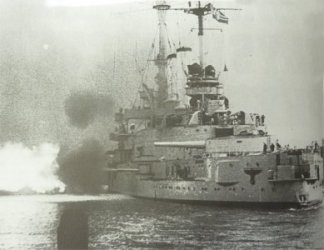
Battleship Schlezwig-Holstein attacks Westerplatte
Polish defense consisted of 950 000 infantry soldiers, 4 300 cannons, 475 tanks and circa 463 planes. The ratio of forces was highly disadvantageous for Poland. It became even more adverse when USSR attacked Poland on east (17 September 1939). Poland had no chance in such battle. Two totalitarian countries, that had almost 270 million people stood together against Republic of Poland with 35 million people.
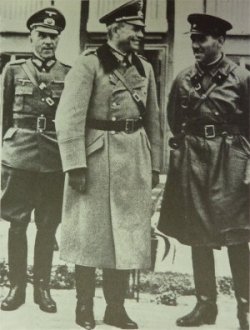
Nazi and Soviet generals during victory parade in Brest (22 September 1939)
German troops pressed forward, using advantage in numbers and technology. Polish armies retreated in heavy fights. Front line was approaching Warsaw. Since the beginning of war capitol city was bombarded. Against vast numbers of German planes, 50 Polish fighters were fighting. However during just the first days of fights Polish pilots destroyed circa 50 enemy planes and 20 more were damaged. Unfortunately 38 planes were lost, as a result Warsaw became almost defenceless against air raids. Whole defense against planes was given to anti-air cannons. Which appeared to be very effective as it brought down 106 German planes. Despite efforts of pilots and gunners, capitol was heavily destroyed, and not only the military buildings but also civilian ones.
Polish defense consisted of 950 000 infantry soldiers, 4 300 cannons, 475 tanks and circa 463 planes. The ratio of forces was highly disadvantageous for Poland. It became even more adverse when USSR attacked Poland on east (17 September 1939). Poland had no chance in such battle. Two totalitarian countries, that had almost 270 million people stood together against Republic of Poland with 35 million people.
4th day of September brought decision about partial evacuation, of the government and some state institutions from Warsaw to Lublin. Next day president Ignacy Moscicki, was evacuated to Lubartow. During the night (6/7th September) near 2.00 in the morning whole government of Poland was evacuated to Luck. Commander-in-chief Edward Smigly-Rydz went to Brest, he left his chief of staff brigadier Waclaw Stachiewicz in Warsaw.
In the meantime new reinforcements were coming to Warsaw. On September the 7th 1939, two battalions: 2nd and 3rd of 40th Infantry Regiment "Dzieci Lwowskie" ("Lvov Children") under commandment of lieutenant colonel Jozef Kalandyk.
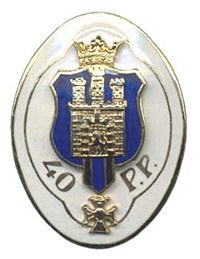
Badge of 40th IR "Lvov Children""
They were immediately allocated to region "Warsaw West" that was including Rakowiec, Ochota and Wola. 7th company from 40 IR along with anti-air battery took positions along both sides of Gorczewska street.
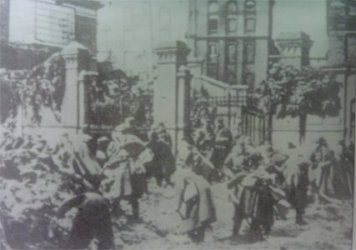
Polish engineers on Gorczewska street
5th company has taken positions between Wolska street and railroad track, and the 8th company commanded by lieutenant Zdzislaw Pacak along with section of anti-tank guns were allocated to Redoubt 56, also known as Sowinski Redoubt, near crossroads of Wolska, Elekcyjna and Redutowa street. On north-western end of Redoubt outside the entrenchment stood little church of st. Lawrence.
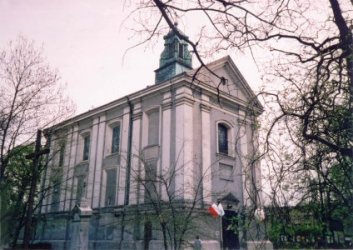
Church of st. Lawrence on Redoubt 5
Immediately after arrival lieutenant Pacak began preparing defensive line. Together with unit commanders he discussed the firing directions and, allocation of anti-tank guns, machineguns, howitzers and soldiers. Together with commander of heavy machineguns - fire support for mortars. And with artillery commanders - support of artillery.
Zdzislaw Pacak recalls:
"Before our lines, wide vegetable fields, along the road barbed wire. Redoubt embankment is quite high, circa 6 meters, when measured from the bottom of the ditch beneath it. Near us low buildings, small bricked houses and gardens. On the back in just circa two and a half meters from the embankment is orthodox cemetery, and bricked fence… To the right when looking from the embankment starts area of 7th company… Anti-tank gun had very wide range of shooting from here.
On the left side of Wolska street key... point was... "Dobrolin" Factory... From there, from street of Jan Kazimierz, area of 5th company of II battalion was starting… Just beside Wolska street was bicycles factory ("Kaminski Factory")."
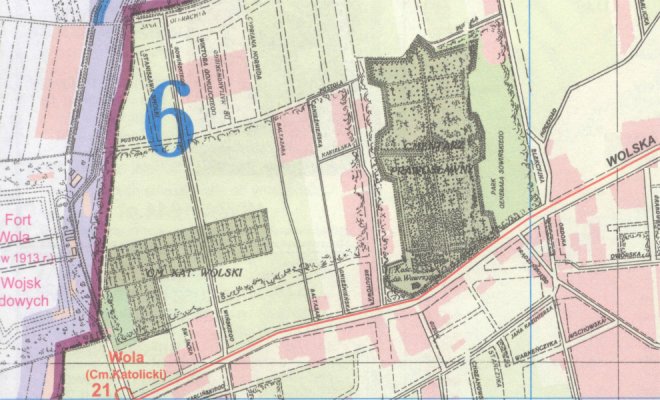
Area that was defended by unit of lieutenant Pacak (map layout from 1939)
On Wolska street beside the "Dobrolin" Factory, precisely on Wolska 157/163, was barricade made of two trams filled with rocks. On both sides of barricade, where buried two iron bars, and between trams in the middle of the street was one-car wide passage. Engineers prepared lines of barbed wire, and anti-tank ditches. On the back opposite to the church were situated stations of heavy machineguns and two anti-tank guns.
Civilians from Wola were helping Army as much as they could. Many volunteers came, some of them are given arms and allocated to the army units. While others are prepared to extinguish fire or help those who are not able to fight to flee from houses, moreover they secure empty houses from thieves. Another duty of those patrols was to catch saboteurs, which were trying to get into the defended area along with refugees. Many others are willing to help in digging ditches, or building barricades. There are more volunteers around than available equipment.
In the "Dobrolin" Factory soldiers found many barrels with turpentine.
In case of air attack they were big threat for barricades, people, and buildings in the area. However lieutenant Pacak founds unconventional way for using the barrels in defending the Redoubt 56.
Commander decided to put them exactly in the places where enemy soldiers will be allocated during the attack. Circa one hundred of barrels were used. It turned out that there were also huge underground tanks with turpentine beneath the factory. Unfortunately there was nothing that soldiers could do with that.
During the action of putting the barrels, Nazi planes came, and bombed the factory, which turned into flames. Lieutenant Pacak ordered immediate evacuation from factory. Troops responsible for extinguishing fire acted quickly and effectively.
More and more refugees were coming to Warsaw. They were getting in through the passage in the barricade. It was a threat for defenders because, the enemy could use that situation, and get in as well. Lieutenant Pacak ignored the orders from his commanders and decided not to close the passage. He did not wanted to leave all those defenseless people outside. Soldiers and volunteers were enforcing the barricade through whole day on 7th and 8th of September.
After 100 kilometers long march on September 8th exactly at 5 pm German troops reached Warsaw. That was the 4th Armored Division. Enemy attacked on south-west suburbs. Germans were certain that Warsaw will be conquered without a fight.
Tanks were decorated with swastika flags. The main attack was made along the Grojecka street in Ochota direction. However that attack was unsuccessful due to strong fire from Polish artillery and anti-tank guns. Some tanks were damaged other retreated together with infantry.
Next day (September 9) Nazis attacked again. After bombardment at 4.45 am, and artillery attack, new offensive started at 7.45 am, 25-30 tanks were used this time. Fights took place mostly on streets: Grojecka, Zwirki i Wigury, Szczesliwicka, and on Narutowicz square. All attacks were repulsed. Moreover Germans lost many soldiers and quite big number of equipment. Due to fiasco of attacks on Ochota general Reinhardt decided to attack Wola. The heaviest fights were in the area defended by 8th company.
Zdzislaw Pacak recalls:
"It was dawn of 9th September. Refugees told us that enemy is approaching...Combat alarm...I send more people for reconnaissance duty...I ordered to open fire only on my command. Sound of trumpet will give the signal, along with other meanings of communication...I took position in the back of barricade, on the embankment near church. Trumpeter just beside me. Under my hand the telephone...
Soldier waits. Full combat readiness...…Reconnaissance is back. I receive the report: tanks are approaching, they force the refugees to run before them...Civilians are running as fast as they can. Anybody who can escapes into the gates of houses that are along the road. Brown-green spot flashed in a distance. One. Two. Tanks. I looked at the trumpeter. He was trebling due to excitement.
The spearhead of the armored column, makes the refugees to run for their lives, and they open fire from machineguns…First dead bodies lie on the street...Tanks and armored cars are spitting the bullets. People are horrified, they run as fast as they can, they fall, they are hit by cars, tanks and horses, they run for the barricade. The column is faster...Dreadful, steel road roller hits and run over the escaping civilians. Caterpillars and wheels are crushing the people, left carts, wheel barrels and strollers… Under the furious steel panting with fire, dying people and animals all of a sudden reassemble falling puppets...
The biggest wish right now is to help these people. But we must allow the enemy to come as close as possible. I bite my lips, as I look on that massacre…The column is approaching... I observe and rate enemy's fire power…In my thoughts I am vindictively admitting, that my assumption was right. Enemy concentrated to much of fire power on such small area, they will not be able to use it effectively. Only the head of column is capable to do that...Tanks are closer. And closer...
The column is crushing the crowd with huge force...The infantry is jumping of the transporters, they run behind the people…Enemy "clears" the area, just before the breaking the last obstacle, as they fought to be the barricade, made of huge bodies of red trams, carts and iron bars.
The crowd is getting smaller. Streams of fire open new gaps in it. There are more and more tanks and armored cars. They are loosing speed. And getting bigger. We are still waiting. The second lasts forever: I don't lose eye from the enemy…There is not a single shot from our side…Trumpeter, stands near me, in the ditch, he look as he has lost faith in his own artistry, he is nervously putting mouthpiece to the lips. He is gazing on me...
First tanks and motorcyclists are just circa one hundred meters away from our positions. We can wait no longer. For the last time I glance on the column, which is so self confident as if it were on parade.
- Trumpeter! The Signal! It got hot. Not even the first bars of melody sounded when the sky over Wola seemed to fall down. The hurricane of bullets, pinned down the steel column. The attack was so sudden and unexpected that the whole head of column, hit with fire, cut across and deep into with hot streams of iron, did not even move...
There was no aiming, there was no time for choosing target. The target was huge. It was road-wide and lasted deep into the street. There was no time to loose! No time to loose!!!
Artillery, anti-tank guns and mortars eagerly choose new targets... Soldier that was using heavy machinegun, was using whole barrels, he was firing incessantly, he did not even had to aim, he always hit someone...
Artillery cut off possibility for reinforcement to come, and the attacker to retreat. Flames erupted. Three tanks already stuck in the head of column blocking the way for others. German soldiers were trying to flee from their tanks, they were running between them trying to hide from dreadful fire behind the steel wall. First groans of German soldiers cut the air.
I had no mercy. Under our guns were dying those who were killing innocent defenseless people, just few minutes ago. Tables have turned... Our soldiers, that have saw the massacre of their countrymen just a while ago, now were doing anything they could to get their revenge... Germans only now cooled a bit from the astonishment.Their first idea was to force through the barricade. They were trying to do the same as the crowd they have killed. The machines moved forward, German guns fired… The pressure of the desperate and determined head of the column was rising. Under protection and assistance of fire from armored cars infantry begins to attack...
Suddenly barrels with turpentine buried in the ground started to burn. Flames are bursting all over the tanks and armored cars. Small in the beginning fire starts to spread quickly, it gets higher and more powerful with every second, to cover whole column just like fire avalanche in the end. The flames roar. Dead bodies are soon covered with fire. Nazis have no time to escape, from open hatches, they are always caught by fire. Screams for help are getting louder, but neither the flames nor the Polish bullets know mercy. The rising temperature and exploding artillery shells, make the barrels with turpentine to fly, and when they hit the ground they explode, making the fire stronger. Eventually due to the turpentine spread German ammunition trucks are in flames as well. The blasts of exploding cars, makes sound of our machineguns inaudible...
Enemy resigned from attacking. Horror-stricken, stunned they looked only for salvation… The attacking machine lost its power. Only one order ruled in the head of column: save your live.
Also some houses are starting to burn... Our artillery, made fire wall that purpose was to prevent attackers from fleeing, however this was so effective that reinforcements coming from direction of Mariawicki church did not know about situation of their colleagues. They simply went into trap, from which there was no escape. The gorge of death draws new machines into it. The area covered with destroyed machines gets bigger.
Over the front roaring with fire, from behind of the red smokes covering us like hell fire, we hear enemy planes. They try to approach our position, but due to the smoke they are not able to identify our positions, and so they resign from bombardment. And more of them, with the same effect...
Germans, lost all observation points, and are not able to aim properly, enemy shoots heavy and densely, but not accurately. Crowded between houses, chased by series of bullets, they panic and try to escape between mighty steel dead bodies of tanks, they rather resemble startled animals than well trained soldiers they used to be.
In a distance, new tanks still try to help in the attack. They are forcing through, not knowing yet accurate fire of our gunners. Destroying their own equipment, crushing and smashing own colleagues even those killed and wounded ones, and in the end they stuck after hit from artillery shell, or they try to escape in panic on reverse gear, bumping into tanks behind them. German attack collapse eventually.
I was able to see the whole road, from the barricade all to the far away distance. Despite the chocking smoke I inhaled deeply... That was turning point. That was our chance to destroy Germans completely... I was sure. And so I gave the order: - Begin assault! Prepare bayonet! The order ran through whole line. Infantry prepares itself for the attack, bayonets are ready. They leap from the trenches.
- Hurray! Hurray! Hurray!
In the same time all heavy machineguns covering infantry attack roared. Soldiers with glittering bayonets ran like mad forward… Short intensive fights began. Enemy soldiers that were withstanding were killed with no mercy. Everybody joined the attack... Officers ran, mixed with soldiers, they were screaming and shivering in lust of fighting enemy...Every single house, every square, and even bend was area of some fighting.
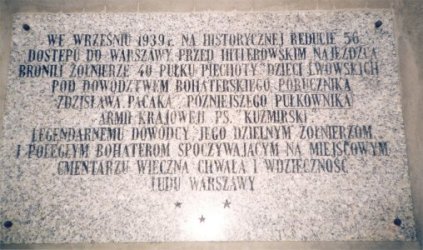
Commemorating plaque on redoubt 56 (photo by Janina Mankowska)
German attacks on Ochota and Wola were a total failure. Infantry troops, left without tank assistance were made to flee from battlefield. Total number of lost german tanks was 45 machines in two days (8 and 9 September). Moreover there were circa 40 more damaged, some of them were later repaired. 4th Armored Division lost 30% of tanks that were used in this assault. Those big losts forced general Reinhard to stop his attack, and withdraw to initial positions. He concluded that without using heavy artillery, flamethrowers, and special equipment for engineers, there is no possibility to take over Warsaw.
However Nazis were trying to find other weak points of Polish defense. All these tries were unsuccessful, and Germans finally resigned from assault, they have chosen siege instead. On September 15th Germans started to close siege ring over Warsaw. Routine bombardments started, as well as artillery shooting. For a while situation changed for more peaceful. Because Nazis concentrated on attempts to destroy Polish forces near Bzura river, where general Kutrzeba was fighting his way to Warsaw. 17th September brought news that, Polish Eastern Borderlands were taken by Soviet Union. From this day Poland was in war with two aggressors. That has not changed morale of Warsaw defenders, but it has complicated badly situation of Polish army fighting in other places.
In the morning of 20th September, from direction of Lasek and Wolka Weglowa, surviving rests of Army Poznan commanded by general Kutrzeba came to Warsaw, siege was now closed. Germans started preparations for final assault.
On a day of 24th September, president of Warsaw Stefan Starzynski made famous speech in radio:
"I wanted Warsaw to be great. I believed that it will be great. I drew along with my cooperator plans, blueprints for great Warsaw.
And Warsaw is great. It happen sooner than we thought. Not in fifty, not in one hundred years time, but know I do see great Warsaw.
As I speak to you in this very moment, I see her in hear greatness and splendor, covered by smoke, red with fire, mighty, indestructible, glorious and fighting Warsaw..."
25th September was beginning of very intensive bombardments, never seen before. Over 400 planes took part in action. 560 tons of exasperating bombs, and 72 tons of incendiary bombs were dropped. Germans felt totally impunity, due to the lack of planes in Polish Army.
German pilots did not take care about any humanitarian aspects nor any international conventions. Mostly civilian targets were attacked. No antiquity, no monuments or churches were safe. Whole quarters of houses were destroyed. German artillery helped in this destruction. Its fire was concentrated on power stations, water filters and pumps, gasworks and telephone wires.
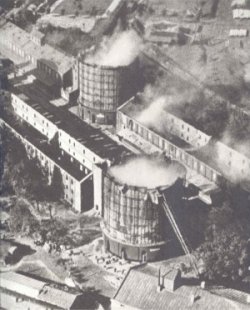 |
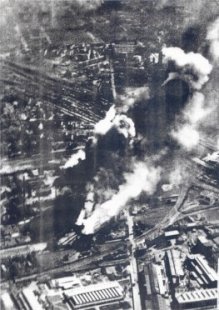 |
Wola burning
Aim of this action was to terrorize Warsaw inhabitants, to destroy the fighting spirit completely. Bombardments took place nonstop from 8 am to 6 pm. Nazis treated Warsaw like testing ground for doctrine of air war, invented by Italian general Gulio Douhat. Doctrine was first tested on smaller area during Spanish Civil War in 1936 on attack on towns of Durango and Guernica.
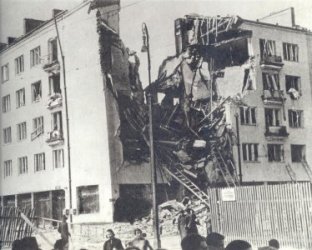 |
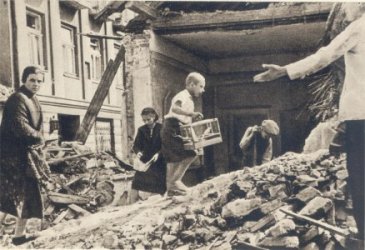 |
Destroyed houses in Wola and Kolo
26th September brought another big German attack. Furious fights in many sites of defense did not bring victory to Nazis. Polish defense was kept in initial positions, and main line of defense was not broken. Nevertheless Polish commanders decided to give up, and to begin treaty talks with Germans. Decisions had to be made due to bad conditions for civilians, because of the bombardment there was no water, food nor hospitals. If the siege would take longer, effects could have been tragic.
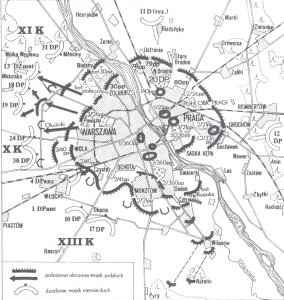
Situation in Warsaw 27 September 1939.
On 27 of September treaty talks have began, first in Sulejowek, later in German commandment outpost of 8th Army in Rakowiec near Okecie. On Polish side was general Kutrzeba and lieutenant Praglowski. Act of capitulation was signed on 28th September 1939, on 1.15 pm. Defense of Wola was held to the end.
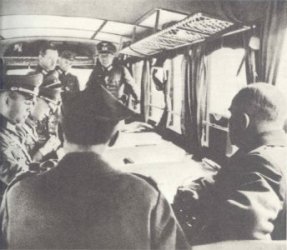
Signing capitulation of Warsaw
On the next day (September 29, 1939) first columns of Polish soldiers left the city. The last column which was commandment one and included generals: Romel, Kutrzeba and Czuma, left city on October 1st. On that day, after all Polish troops left Warsaw, Germans entered Downtown district. Exactly on 3pm Nazis took watch in city main Police Headquarters, and using the megaphones announced taking over the city.
During the Warsaw defense (1st-28th September 1939) 5 000 Polish soldiers died, circa 16 000 were wounded. Over 15 000 civilians died, many more were wounded. Circa 5 000 officers, and over 97 000 privates became prisoners of war.
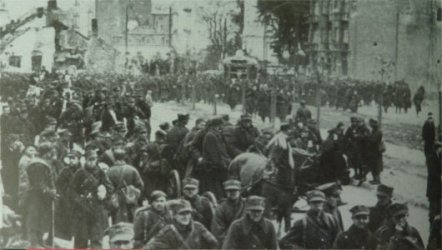
Warsaw defenders are taken to prison camps
12% of buildings were destroyed, including many historical monuments and antiques. Cost were counted over 3 billions of the then Polish zlote. Dark Nazi night fell over the city for nearly 5 years.
After capitulation one more important event took place. In Moscow Ribbentrop and Molotov signed German-Soviet act of friendship and borders" (28th September 1939). Secret protocol described borders of interest for both countries. Lubelszczyzna and part of Mazowsze was taken by Germany, while Polish Eastern Borderlands by USSR. Germans agreed on taking Lithuania by Soviet Union, but demanded Lubelszczyzna. Moreover protocol was saying about destroying any independence attempts in Poland. As a result of this division, Germany has taken 48,5% of area and circa 20,4 million people that belonged to Poland before war. Soviet Union took 50% of Polish territory and 14,3 million people. USSR gave Lithuania Vilnius and some area near city that was circa 1,5% of Polish lands and 500 000 Poles. However in few months this area was back in USSR, after annection of Lithuania in August 1940.
Commander of defense on Redoubt 56, was promoted to the rank of captain. Zdzislaw Pacak was imprisoned after capitulation along with other Polish troops. He was sent to POW camp in Woldenberg. He had three attempts for escape. And the third very brave one that took place in march 1942 was successful. Captain along with four other officers after adventures like in cinema came safely to Warsaw. Immediately he comes to serve in Domestic Army under pseudonym "Kuzmirski". In November 1942, he became assistant and an operational chief of Special Actions Organization "Wasp" (Polish name of organization was Osa (eng. wasp) and that was an abbreviation of Organizacja Specjalnych Akcji). From 1943 to 1944 he was commander of Carpathian Partisans Division, of Lviv Home Army. He was later promoted to lieutenant colonel of Domestic Army. Bachelor of Gold and Silver Cross Virtuti, Brave Cross and many other army medals. He was arrested by Russian NKVD ( People Commissariat for Internal Affairs), in prison on Lubianka, he is witness in trial of sixteen.He is back in Poland in 1946. Again arrested this time by Polish UB (Ministry of Public Security of Poland), he was in prison for 6 six years, first in Rawicz then in Wronki. He died on 27th January 1981 in Cracow.
On 11th April 2005 City Council of Warsaw, decided after council of Wola district application to give name to square situated between Wolska, Kasprzaka and Ordona street of Lieutenant Zdzislaw Pacak-Kuzmirski.
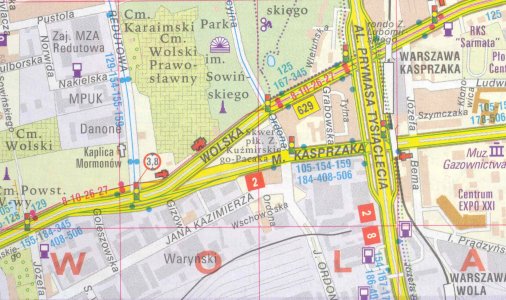
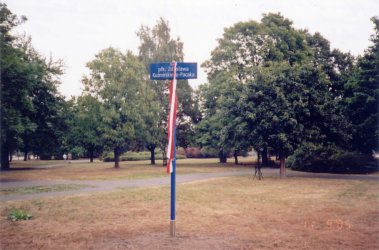
Lieutenant Zdzislaw Pacak-Kuzmierski square
Square is placed near the Redoubt 56, between two important roads, which are entrance to city from west.
Compiled by:
Maciej Janaszek-Seydlitz
Jerzy Janowski
Janina Mañkowska
Translation: Kamil Kornatka
Copyright © 2010 Maciej Janaszek-Seydlitz. All rights reserved.